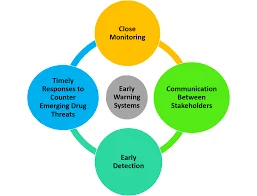
Why in news?
- Extreme weather events are no longer a looming threat; they are a stark reality for communities across the globe.
- From devastating floods and cyclones to scorching heatwaves and unpredictable droughts, these events wreak havoc on lives and livelihoods.
- Recognizing this growing challenge, India has taken a proactive step to assist its neighbors and small island nations by developing early warning systems (EWS) – a crucial line of defense against the fury of nature.
Why is India Helping?
- The impetus behind this initiative is clear – to save lives and property.
- Many developing countries, particularly those categorized as least developed or small island nations, lack the financial and technological resources to establish robust EWS.
- Countries like Nepal, Maldives, Sri Lanka, Bangladesh, and Mauritius stand particularly vulnerable.
- India, with its well-established meteorological department (IMD) and growing expertise in disaster management, aims to bridge this gap.
- This initiative aligns perfectly with the United Nations’ ‘Early Warnings for All’ program, which underscores the importance of global collaboration in mitigating the impact of natural disasters.
India’s Role: A Multi-Pronged Approach
- India’s approach to supporting its partner nations goes beyond simply offering aid.
- It’s a comprehensive strategy encompassing technical expertise, financial assistance, and infrastructure development:
- Technical Expertise:
- India will share its knowledge and experience in establishing and managing EWS.
- This includes training personnel, setting up protocols, and best practices for data analysis and forecasting.
- Financial Assistance:
- Recognizing the resource constraints of partner nations, India will leverage public-private partnerships (PPP) for financial support.
- This ensures a sustainable funding mechanism for EWS development and maintenance.
- Infrastructure Development:
- Partner countries will benefit from India’s assistance in setting up meteorological observatories.
- These observatories will collect real-time weather data, crucial for accurate forecasting and issuing timely warnings.
- Data Sharing and Communication:
- Access to India’s sophisticated numerical models will enhance the forecasting capabilities of partner nations.
- Additionally, collaboration between communication ministries will facilitate seamless data exchange and efficient warning dissemination systems.
- Technical Expertise:
The Urgent Need for Early Warning Systems
- The growing frequency and intensity of extreme weather events highlight the critical need for EWS. Consider these alarming trends:
- Global Surge:
- A World Meteorological Organization (WMO) report reveals a fivefold increase in natural disasters between 1970 and 2019. Water-related events pose the most significant threat globally.
- Asia’s Vulnerability:
- The Asian continent bears a significant brunt, with over 146,000 lives lost and more than 911 million people directly affected by disasters between 2013 and 2022. Economic losses in 2022 alone surpassed USD 36 billion, primarily due to floods and storms.
- Human and Economic Costs:
- From 1970 to 2021, weather-related disasters claimed over two million lives and inflicted economic losses exceeding USD 4.3 trillion.
- Global Surge:
Climate Change: A Threat Multiplier
- The specter of climate change looms large, exacerbating the frequency and intensity of extreme weather events.
- This makes disaster management even more complex and reinforces the need for robust EWS.
- By 2030, estimates suggest an alarming rise, with the world potentially facing 560 medium- to large-scale disasters annually.
India as a Leader in Early Warning Systems
- India’s initiative serves as a beacon of hope, demonstrating the importance of international cooperation in addressing the challenges posed by natural disasters and climate change.
- The IMD, established in 1875, stands as a testament to India’s longstanding commitment to weather forecasting and disaster preparedness.
The ‘Early Warnings for All’ Initiative
- India’s efforts are not in isolation. They contribute significantly to the ‘Early Warnings for All’ initiative, co-led by the WMO and the UN Office for Disaster Risk Reduction (UNDRR). This initiative rests on four pillars:
- Disaster Risk Knowledge and Management:
- Building awareness and understanding of disaster risks is the first step towards preparedness and mitigation.
- Detection, Observation, Monitoring, Analysis, and Forecasting:
- Establishing robust EWS hinges on reliable data collection and accurate weather forecasting.
- Warning Dissemination and Communication:
- Timely and effective communication of warnings to communities at risk is paramount.
- Preparedness and Response Capabilities:
- Building community resilience through drills, evacuation plans, and stockpiling essential supplies empowers communities to respond effectively during disasters.
- Disaster Risk Knowledge and Management:
Conclusion
- India’s initiative to support partner nations in developing Early Warning Systems is a commendable step towards a safer future.
- It underscores the importance of international cooperation and knowledge-sharing in combating the growing threat of natural disasters. By working together, we can build a more resilient
People also ask
Q1: What is India’s initiative on Early Warning Systems (EWS) about?
Ans: India is assisting developing countries, particularly those most vulnerable, by providing technical expertise, financial aid, and infrastructure development to establish robust EWS. This aligns with the UN’s ‘Early Warnings for All’ program.
Q2: Why are Early Warning Systems (EWS) important?
Ans: Early Warning Systems play a crucial role in mitigating the impact of natural disasters like floods, cyclones, heatwaves, and droughts. They provide timely warnings, allowing communities to evacuate, take precautions, and minimize loss of life and property.
Q3: Which countries are benefiting from India’s Early Warning Systems initiative?
Ans: India is prioritizing collaboration with Nepal, Maldives, Sri Lanka, Bangladesh, and Mauritius, but the initiative can be extended to other vulnerable nations.
Can you be more specific about the content of your article? After reading it, I still have some doubts. Hope you can help me.